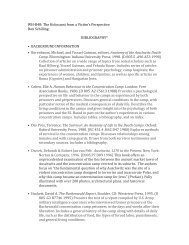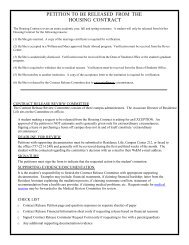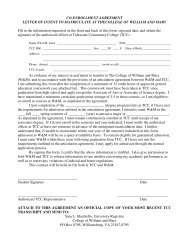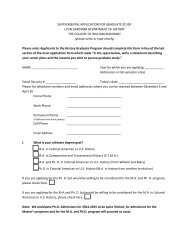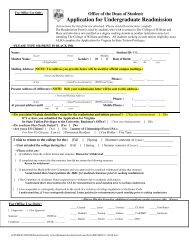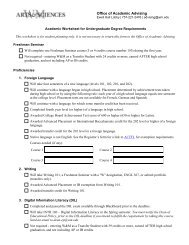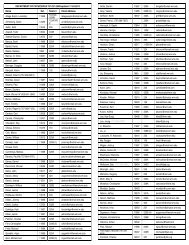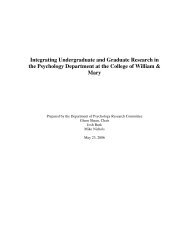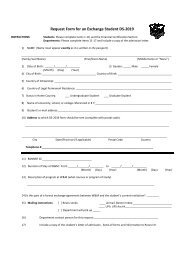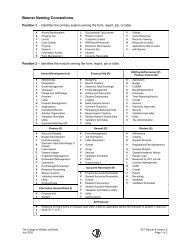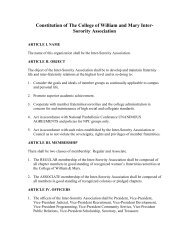Course Selection Guidebook [pdf] - College of William and Mary
Course Selection Guidebook [pdf] - College of William and Mary
Course Selection Guidebook [pdf] - College of William and Mary
You also want an ePaper? Increase the reach of your titles
YUMPU automatically turns print PDFs into web optimized ePapers that Google loves.
<strong>Course</strong> <strong>Selection</strong> <strong>Guidebook</strong> – Fall 2011students who want to take one <strong>of</strong> the introductory courses to consider one or both <strong>of</strong> the othercourses as an alternate selection for their first choice.Students planning to major in geology commonly take Geology 101, 110, or 150 as well asGeology 160 in the fall <strong>and</strong> another Geology course in the spring <strong>of</strong> their first year; for example,Geology 322, The Sedimentary Record, Geology 323, Earth Structure <strong>and</strong> Dynamics, Geology305, Environmental Geology, or one <strong>of</strong> the other spring Geology courses. We strongly encourageanyone with an interest in Geology to consult with Geology faculty members in the fall semester todiscuss spring courses. We also encourage students to talk with faculty members aboutrequirements for the Geology major <strong>and</strong> to learn about opportunities for field trips <strong>and</strong> pre-collegeoutreach activities. All 200 <strong>and</strong> 300 level Geology courses require either Geology 101, 110, or 150as a prerequisite. The Department <strong>of</strong>fers a variety <strong>of</strong> courses, including Environmental Geology,Earth Surface Processes, Rock Forming Minerals, Hydrology, Watershed Dynamics, Paleontology,<strong>and</strong> Planetary Geology, for students who wish to continue the study <strong>of</strong> Geology.For more information, please contact Christopher Bailey, Department Chair, at cmbail@wm.eduor (757) 221-2445. The department webpage http://www.wm.edu/as/geology/index.php also hasuseful information about the faculty <strong>and</strong> programs in the department.Introductory <strong>Course</strong>s101. The Dynamic Earth: Physical Geology - (GER 2A) Fall <strong>and</strong> Spring (3) An investigation <strong>of</strong>the major features <strong>of</strong> the Earth <strong>and</strong> its materials <strong>and</strong> the interaction <strong>of</strong> the geologic processes activeon the surfaces <strong>and</strong> in the interior <strong>of</strong> the Earth. Topics include volcanoes, rivers, glaciers,earthquakes, natural resources, <strong>and</strong> global change.110. Earth’s Environmental Systems: Physical Geography - (GER 2A) Fall <strong>and</strong> Spring (3)Introduction to the interactions between the Earth’s environmental systems - the atmosphere,hydrosphere, biosphere, <strong>and</strong> solid earth. Emphasis will be placed on the relationship between theenvironment <strong>and</strong> the human condition.150W. Reading the Earth – Fall (4) This course will introduce students to the geosciences byreading essays, articles, <strong>and</strong> books <strong>and</strong> by “reading the Earth in the laboratory <strong>and</strong> field. Topicswill include geologic time, geologic maps, plate tectonics, <strong>and</strong> unraveling the geologic history <strong>of</strong>selected times <strong>and</strong> places. Two required Saturday field trips.160. Investigating the Earth: Introductory Geology Laboratory (GER 2 Lab) Fall <strong>and</strong> Spring (1)Laboratory techniques in physical geology. Required field trips. Three laboratory hours.Investigating the Earth through exercises involving observations <strong>and</strong> interpretations <strong>of</strong> maps,minerals <strong>and</strong> rocks, groundwater <strong>and</strong> streams, coastal processes <strong>and</strong> earthquakes.204. GIS in Earth <strong>and</strong> Environmental Sciences – Fall <strong>and</strong> Spring (3) This course will provide anintroduction to using Geographic Information Systems (GIS) as a tool in Earth <strong>and</strong> environmentalscience <strong>and</strong> policy. Emphasis will be on h<strong>and</strong>s-on application <strong>of</strong> GIS to create maps, to organize<strong>and</strong> visualize spatial data, <strong>and</strong> to query spatial data to elucidate answers to Earth <strong>and</strong>environmental questions.305. Environmental Geology - Spring (3) The application <strong>of</strong> geology toward underst<strong>and</strong>ing theconnection between human activities <strong>and</strong> the environment. Topics include climate change,41


![Course Selection Guidebook [pdf] - College of William and Mary](https://img.yumpu.com/46952524/41/500x640/course-selection-guidebook-pdf-college-of-william-and-mary.jpg)
